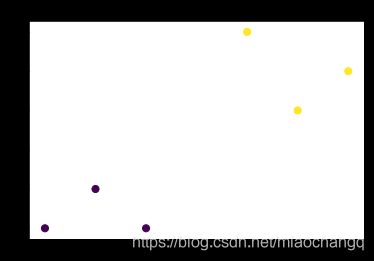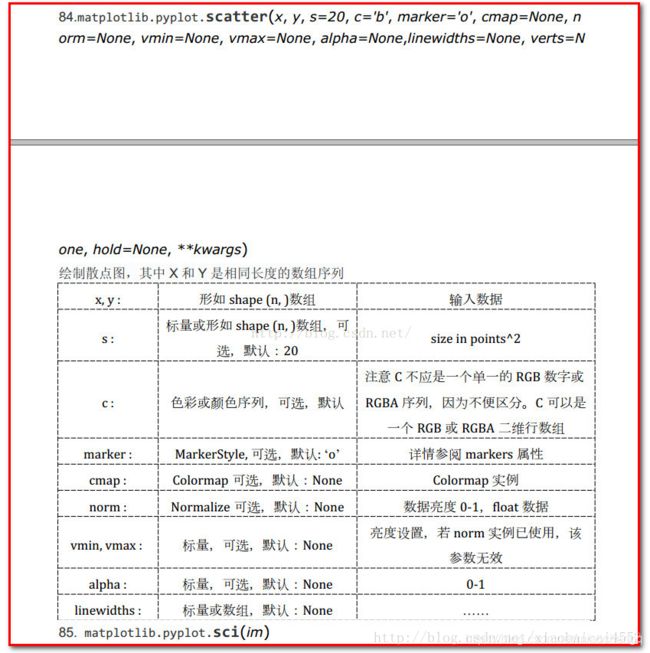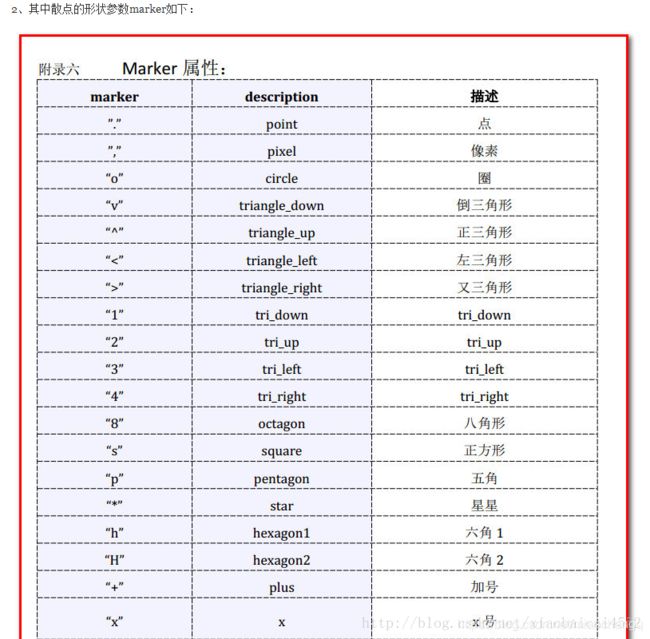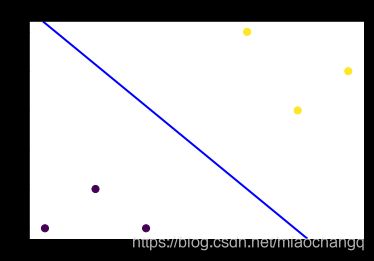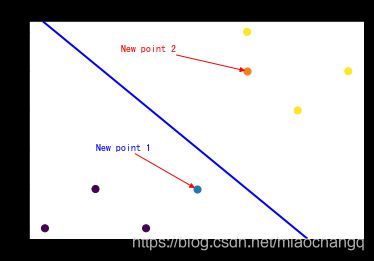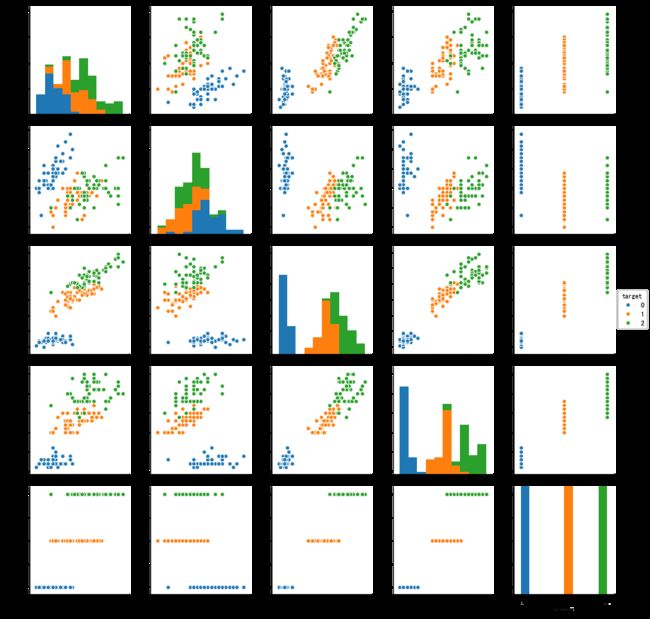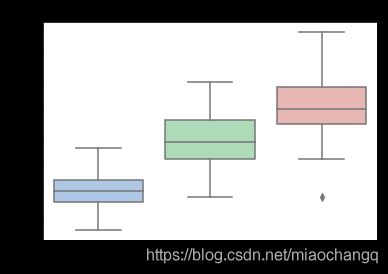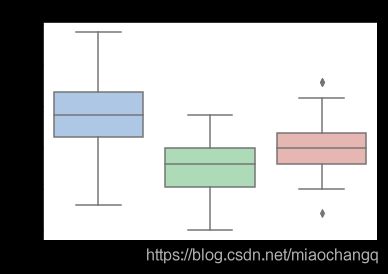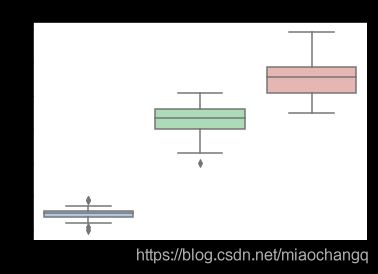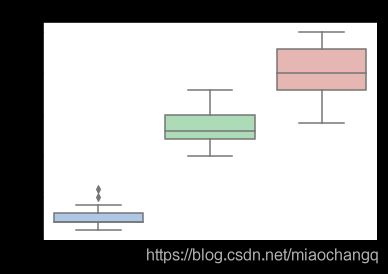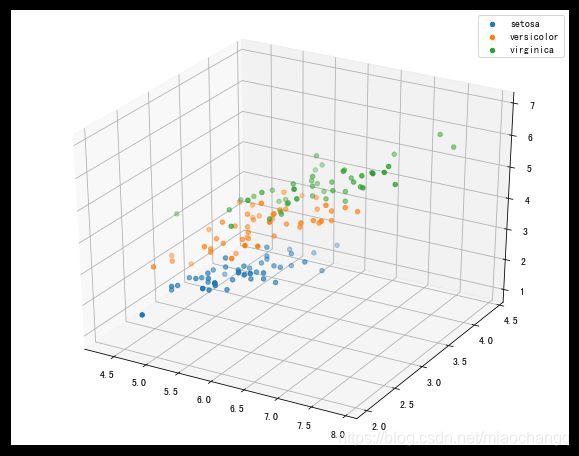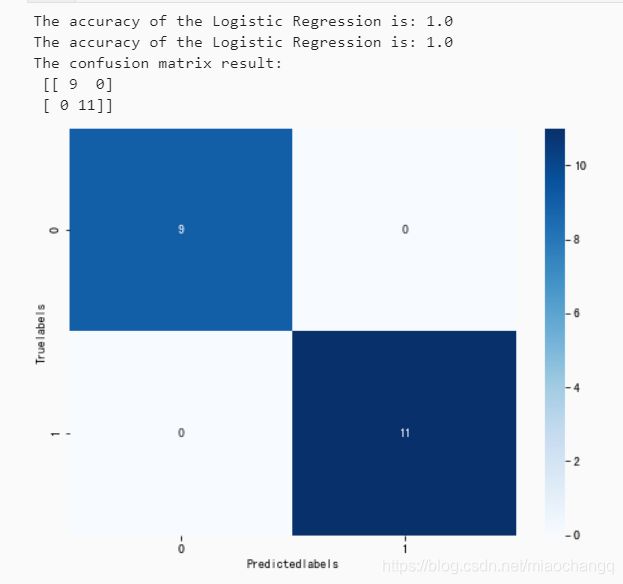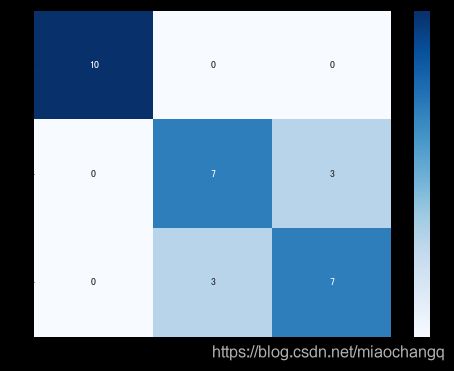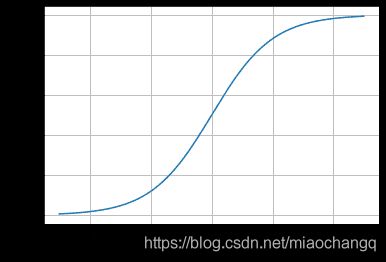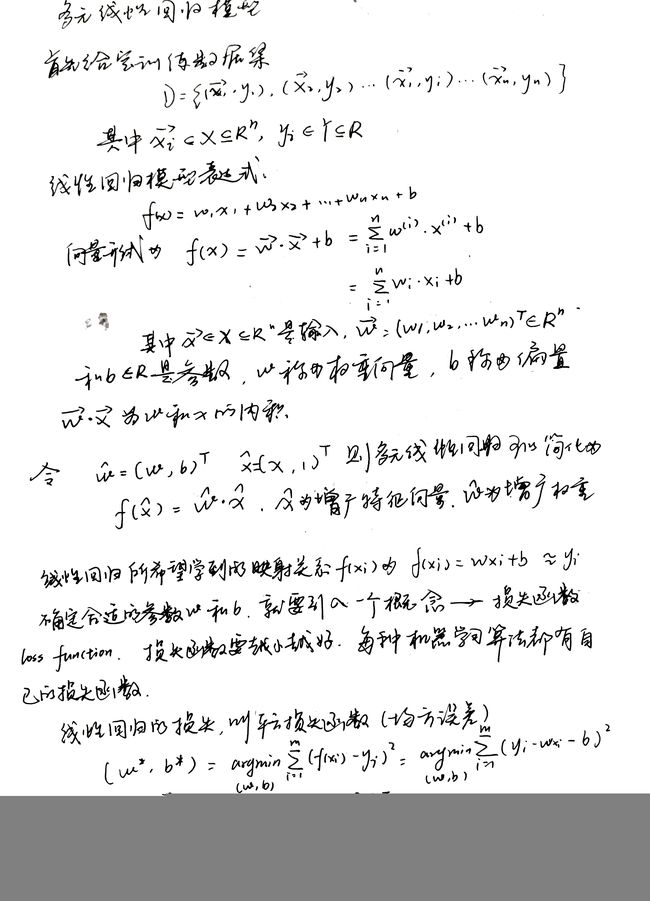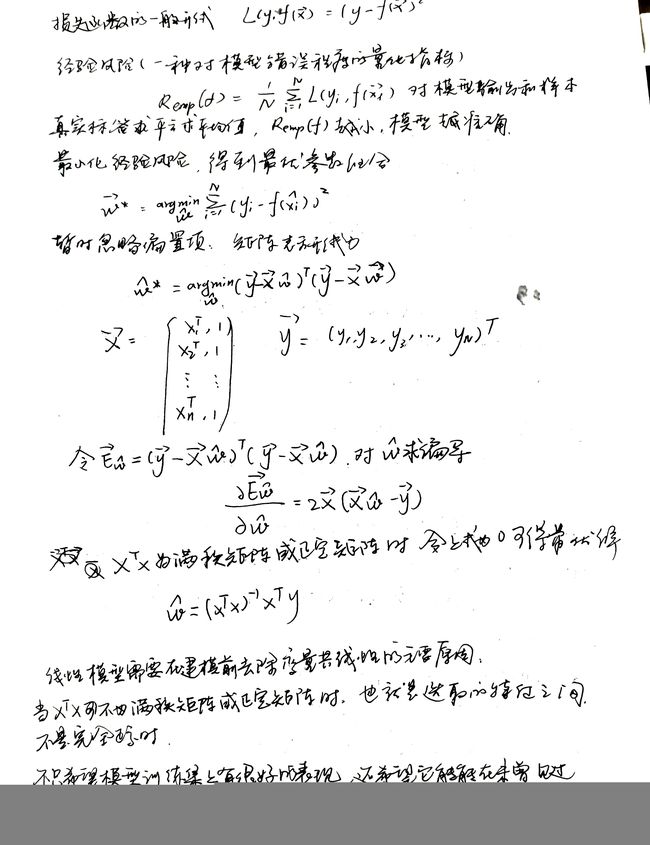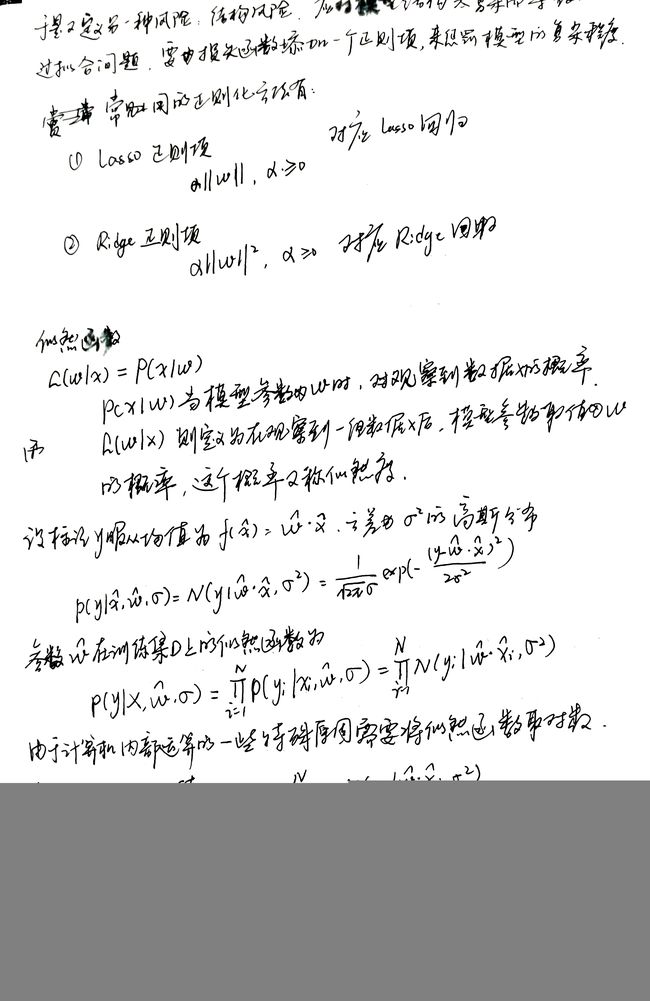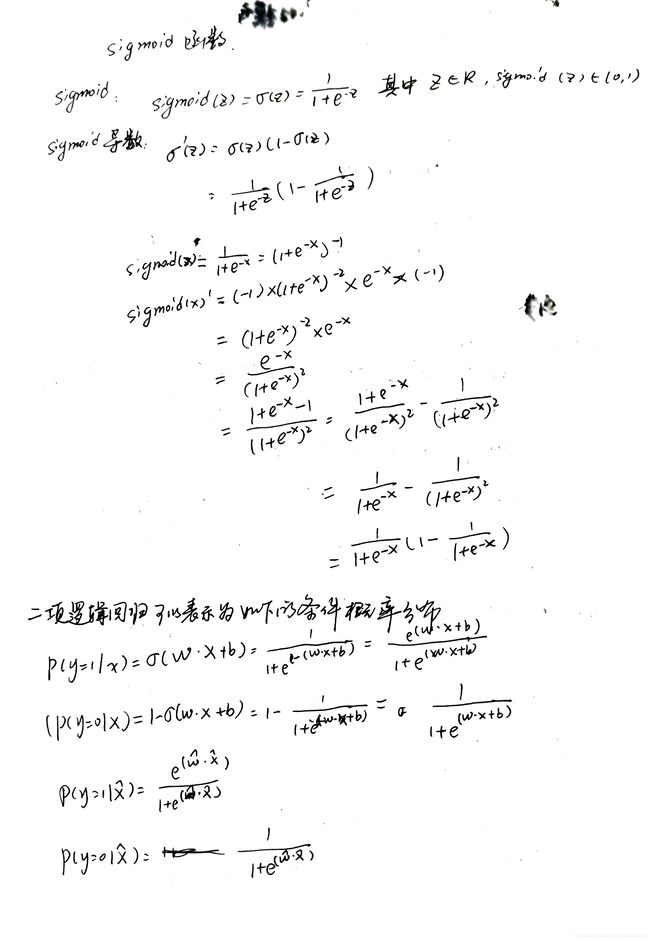DataWhale基于逻辑回归的分类预测模型
DataWhale基于逻辑回归的分类预测
- Demo示例
- 库函数导入
- 训练模型
- 模型参数查看
- 可视化构造的数据样本点
- 可视化决策边界
- 可视化预测新样本
- 在训练集和测试集上分布利用训练好的模型进行预测
- 基于鸢尾花(iris)数据集的逻辑回归分类实践
- 数据读取/载入
- 数据信息简单查看
- 特征数据
- 标签数据
- 可视化描述
- 利用 逻辑回归模型 在二分类上 进行训练和预测
- 数据集划分
- 模型训练
- 评估分类结果
- 利用 逻辑回归模型 在三分类(多分类)上 进行训练和预测
- 逻辑回归原理简介
Demo示例
库函数导入
import numpy as np
import matplotlib.pyplot as plt
import seaborn as sns
from sklearn.linear_model import LogisticRegression
训练模型
#构造数据集
x_fearures = np.array([[-1, -2], [-2, -1], [-3, -2], [1, 3], [2, 1], [3, 2]])#
y_label = np.array([0, 0, 0, 1, 1, 1])
对应的数据集为
| x1 | x2 | y |
|---|---|---|
| -1 | -2 | 0 |
| -2 | -1 | 0 |
| -3 | -2 | 0 |
| 1 | 3 | 1 |
| 2 | 1 | 1 |
| 3 | 2 | 1 |
#调用逻辑回归模型
lr_clf = LogisticRegression()#实例化LogisticRegression()类
#用逻辑回归模型拟合构造的数据集
lr_clf = lr_clf.fit(x_fearures, y_label) #其拟合方程为 y=w0+w1*x1+w2*x2
模型参数查看
##查看其对应模型的w1和w2 也就是系数
print('the weight of Logistic Regression:',lr_clf.coef_)
##查看其对应模型的w0 也就是截距
print('the intercept(w0) of Logistic Regression:',lr_clf.intercept_)
##the weight of Logistic Regression:[[0.73462087 0.6947908]]
##the intercept(w0) of Logistic Regression:[-0.03643213]
#逻辑回归的拟合结果的.coef_和.intercept_返回的均为list类型,使用时要加以注意
可视化构造的数据样本点
plt.figure()#新建一个画布
plt.scatter(x_fearures[:,0],x_fearures[:,1], c=y_label, s=50, cmap='viridis')
plt.title('Dataset')
plt.show()
- 其中涉及到matplotlib的使用,请看下图(图片来源于网络)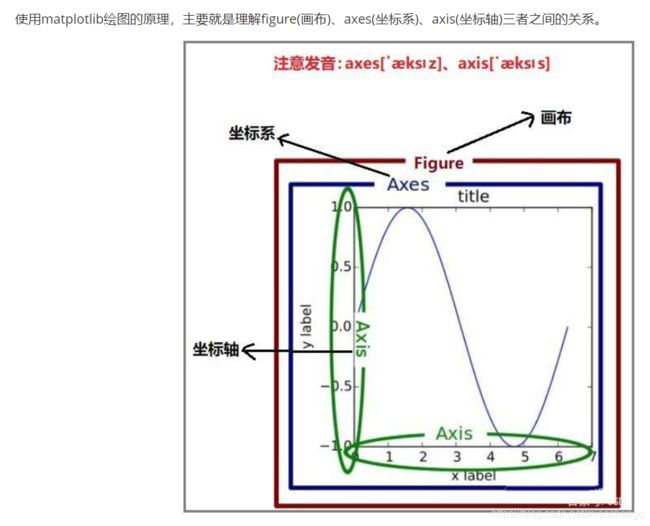
一个figure(画布)上,可以有多个区域axes(坐标系),我们在每个坐标系上绘图,也就是说每个axes(坐标系)中,都有一个axis(坐标轴)。
- plt.scatter
scatter(x, y, s=None, c=None, marker=None, cmap=None, norm=None, vmin=None, vmax=None, alpha=None, linewidths=None, verts=None, edgecolors=None, hold=None, data=None, **kwargs)
#参数说明
'''
x,y:array_like,shape(n,)
输入数据
s:标量或array_like,shape(n,),可选
大小以点数^ 2。默认是`rcParams ['lines.markersize'] ** 2`。
c:颜色,顺序或颜色顺序,可选,默认:'b'
`c`可以是单个颜色格式的字符串,也可以是一系列颜色
规范的长度为`N`,或一系列`N`数字
使用通过kwargs指定的`cmap`和`norm`映射到颜色
(见下文)。请注意,`c`不应该是单个数字RGB或
RGBA序列,因为这与数组无法区分
值将被彩色映射。 `c`可以是一个二维数组,其中的
行是RGB或RGBA,但是,包括单个的情况
行为所有点指定相同的颜色。
marker:`〜matplotlib.markers.MarkerStyle`,可选,默认值:'o'
请参阅`〜matplotlib.markers`以获取有关不同的更多信息
标记分散支持的样式。 `marker`可以是
该类的实例或特定文本的简写
标记。
cmap:`〜matplotlib.colors.Colormap`,可选,默认:无
一个`〜matplotlib.colors.Colormap`实例或注册名称。
`cmap`仅在`c`是浮点数组时使用。如果没有,
默认为rc`image.cmap`。
norm:`〜matplotlib.colors.Normalize`,可选,默认:无
`〜matplotlib.colors.Normalize`实例用于缩放
亮度数据为0,1。`norm`只有在`c`是一个数组时才被使用
彩车。如果`None',则使用默认值:func:`normalize`。
vmin,vmax:标量,可选,默认值:无
`vmin`和`vmax`与`norm`结合使用来标准化
亮度数据。如果其中任何一个都是`无',那么最小和最大的
使用颜色数组。请注意,如果你通过一个“规范”实例,你的
`vmin`和`vmax`的设置将被忽略。
alpha:标量,可选,默认值:无
alpha混合值,介于0(透明)和1(不透明)之间,
linewidths:标量或array_like,可选,默认值:无
如果无,则默认为(lines.linewidth,)。
verts:(x,y)的序列,可选
如果`marker`为None,这些顶点将用于
构建标记。标记的中心位于
在(0,0)为标准化单位。整体标记重新调整
由``s``完成。
edgecolors :颜色或颜色顺序,可选,默认值:无
如果无,则默认为'face'
如果'face',边缘颜色将永远是相同的
脸色。
如果它是'none',补丁边界不会
被画下来。
对于未填充的标记,“edgecolors”kwarg
被忽视并被迫在内部“面对”。
'''
可视化决策边界
plt.figure()#初始化画布
plt.scatter(x_fearures[:,0],x_fearures[:,1], c=y_label, s=50, cmap='viridis')#画散点图
plt.title('Dataset')#设置图像标题
nx, ny = 200, 100
x_min, x_max = plt.xlim()#获取或者是设定x座标轴的范围,当前axes上的x座标轴。
y_min, y_max = plt.ylim()#获取或者是设定y座标轴的范围,当前axes上的y座标轴。
x_grid, y_grid = np.meshgrid(np.linspace(x_min, x_max, nx),np.linspace(y_min, y_max, ny))
'''
#numpy.meshgrid()——生成网格点坐标矩阵。
#np.linspace主要用来创建等差数列
#numpy.linspace(start, stop, num=50, endpoint=True, retstep=False, dtype=None, axis=0)
start:返回样本数据开始点
stop:返回样本数据结束点
num:生成的样本数据量,默认为50
endpoint:True则包含stop;False则不包含stop
retstep:If True, return (samples, step), where step is the spacing between samples.(即如果为True则结果会给出数据间隔)
dtype:输出数组类型
axis:0(默认)或-1
'''
z_proba = lr_clf.predict_proba(np.c_[x_grid.ravel(), y_grid.ravel()])
'''
numpy.ravel()将多维数组拉平
np.c_np.c_是按行连接两个矩阵,就是把两矩阵左右相加,要求行数相等,类似于pandas中的merge()。
-------------------a------------------
[[1 2 3]
[4 5 6]]
-------------------b------------------
[[0 0 0]
[1 1 1]]
-------------------np.r_[a,b]--------------------
[[1 2 3]
[4 5 6]
[0 0 0]
[1 1 1]]
--------------------np.c_[a,b]-------------------
[[1 2 3 0 0 0]
[4 5 6 1 1 1]]
'''
z_proba = z_proba[:, 1].reshape(x_grid.shape)
plt.contour(x_grid, y_grid, z_proba, [0.5], linewidths=2., colors='blue')#对网格中每个点的值等于一系列值的时候做出一条条轮廓线,类似于等高线 。
plt.show()
可视化预测新样本
plt.figure()#新画布
x_fearures_new1 = np.array([[0, -1]])#一个新的要预测的样本点
plt.scatter(x_fearures_new1[:,0],x_fearures_new1[:,1], s=50, cmap='viridis')
plt.annotate(s='New point 1',xy=(0,-1),xytext=(-2,0),color='blue',arrowprops=dict(arrowstyle='-|>',connectionstyle='arc3',color='red'))#对样本进行标注
x_fearures_new2 = np.array([[1, 2]])#一个新的要预测的样本点
plt.scatter(x_fearures_new2[:,0],x_fearures_new2[:,1], s=50, cmap='viridis')
plt.annotate(s='New point 2',xy=(1,2),xytext=(-1.5,2.5),color='red',arrowprops=dict(arrowstyle='-|>',connectionstyle='arc3',color='red'))
## 训练样本
plt.scatter(x_fearures[:,0],x_fearures[:,1], c=y_label, s=50, cmap='viridis')
plt.title('Dataset')
# 可视化决策边界
plt.contour(x_grid, y_grid, z_proba, [0.5], linewidths=2., colors='blue')
plt.show()
在训练集和测试集上分布利用训练好的模型进行预测
y_label_new1_predict=lr_clf.predict(x_fearures_new1)
y_label_new2_predict=lr_clf.predict(x_fearures_new2)
print('The New point 1 predict class:\n',y_label_new1_predict)
print('The New point 2 predict class:\n',y_label_new2_predict)
##由于逻辑回归模型是概率预测模型(前文介绍的p = p(y=1|x,\theta)),所有我们可以利用predict_proba函数预测其概率
y_label_new1_predict_proba=lr_clf.predict_proba(x_fearures_new1)
y_label_new2_predict_proba=lr_clf.predict_proba(x_fearures_new2)
print('The New point 1 predict Probability of each class:\n',y_label_new1_predict_proba)
print('The New point 2 predict Probability of each class:\n',y_label_new2_predict_proba)
'''
输出:
The New point 1 predict class:
[0]
The New point 2 predict class:
[1]
The New point 1 predict Probability of each class:
[[ 0.67507358 0.32492642]]
The New point 2 predict Probability of each class:
[[ 0.11029117 0.88970883]]
'''
基于鸢尾花(iris)数据集的逻辑回归分类实践
本次我们选择鸢花数据(iris)进行方法的尝试训练,该数据集一共包含5个变量,其中4个特征变量,1个目标分类变量。共有150个样本,目标变量为 花的类别 其都属于鸢尾属下的三个亚属,分别是山鸢尾 (Iris-setosa),变色鸢尾(Iris-versicolor)和维吉尼亚鸢尾(Iris-virginica)。包含的三种鸢尾花的四个特征,分别是花萼长度(cm)、花萼宽度(cm)、花瓣长度(cm)、花瓣宽度(cm),这些形态特征在过去被用来识别物种。
| 变量 | 描述 |
|---|---|
| sepal length | 花萼长度(cm) |
| sepal width | 花萼宽度(cm) |
| petal length | 花瓣长度(cm) |
| petal width | 花瓣宽度(cm) |
| target | 鸢尾的三个亚属类别,‘setosa’(0), ‘versicolor’(1), ‘virginica’(2) |
数据读取/载入
from sklearn.datasets import load_iris##我们利用sklearn中自带的iris数据作为数据载入,并利用Pandas转化为DataFrame格式
data = load_iris() #得到数据特征,data为一个字典类型,其中包括了['data', 'target', 'target_names', 'DESCR', 'feature_names']
print(data['DESCR'])#查看官方说明
iris_target = data.target #得到数据对应的标签
iris_features = pd.DataFrame(data=data.data, columns=data.feature_names) #利用Pandas转化为DataFrame格式
数据信息简单查看
特征数据
iris_features.info()
iris_features.head(5)
iris_features.tail()
iris_features.describe()
标签数据
pd.Series(iris_target).value_counts()#类似groupby函数功能
可视化描述
## 合并标签和特征信息
iris_all = iris_features.copy() ##进行浅拷贝,防止对于原始数据的修改
iris_all['target'] = iris_target
## 特征与标签组合的散点可视化
sns.pairplot(data=iris_all,diag_kind='hist', hue= 'target')
plt.show()
- 上图对角线直方图表示各列的分布情况
- 而非对角线上是两个不同属性之间的相关图
-
- 不同的特征组合对于不同类别的花的散点分布,以及大概的区分能力,比如子图[4,2]
- 更多用法请点击本链接
#逐变量绘制箱型图可以得到不同类别在不同特征上的分布差异情况。
for col in iris_features.columns:
sns.boxplot(x='target', y=col, saturation=0.5,
palette='pastel', data=iris_all)
plt.title(col)
plt.show()
# 选取其前三个特征绘制三维散点图
from mpl_toolkits.mplot3d import Axes3D #导入3D坐标系
fig = plt.figure(figsize=(10,8))#初始画布
ax = fig.add_subplot(111, projection='3d')#添加子图
iris_all_class0 = iris_all[iris_all['target']==0].values#分类一
iris_all_class1 = iris_all[iris_all['target']==1].values#分类二
iris_all_class2 = iris_all[iris_all['target']==2].values#分类三
# 'setosa'(0), 'versicolor'(1), 'virginica'(2)
ax.scatter(iris_all_class0[:,0], iris_all_class0[:,1], iris_all_class0[:,2],label='setosa')
ax.scatter(iris_all_class1[:,0], iris_all_class1[:,1], iris_all_class1[:,2],label='versicolor')
ax.scatter(iris_all_class2[:,0], iris_all_class2[:,1], iris_all_class2[:,2],label='virginica')
plt.legend()#添加图例
plt.show()
利用 逻辑回归模型 在二分类上 进行训练和预测
数据集划分
##为了正确评估模型性能,将数据划分为训练集和测试集,并在训练集上训练模型,在测试集上验证模型性能。
from sklearn.model_selection import train_test_split
##选择其类别为0和1的样本(不包括类别为2的样本)
iris_features_part=iris_features.iloc[:100]
iris_target_part=iris_target[:100]
#前100样本为0,1类样本
#后50样本为2类样本
##测试集大小为20%,80%/20%分
x_train,x_test,y_train,y_test=train_test_split(iris_features_part,iris_target_part,test_size=0.2,random_state=2020)
模型训练
##从sklearn中导入逻辑回归模型
from sklearn.linear_model import LogisticRegression
##定义逻辑回归模型
clf=LogisticRegression(random_state=0,solver='lbfgs')
##在训练集上训练逻辑回归模型
clf.fit(x_train,y_train)
##查看其对应的w
print('the weight of Logistic Regression:',clf.coef_)
##查看其对应的w0
print('the intercept(w0) of Logistic Regression:',clf.intercept_)
#the weight of Logistic Regression: [[ 0.45244919 -0.81010583 2.14700385 0.90450733]]
#the intercept(w0) of Logistic Regression: [-6.57504448]
##在训练集和测试集上分布利用训练好的模型进行预测
train_predict=clf.predict(x_train)
test_predict=clf.predict(x_test)
评估分类结果
from sklearn import metrics
##利用accuracy(准确度)【预测正确的样本数目占总预测样本数目的比例】评估模型效果
print('The accuracy of the Logistic Regression is:',metrics.accuracy_score(y_train,train_predict))
print('The accuracy of the Logistic Regression is:',metrics.accuracy_score(y_test,test_predict))
##查看混淆矩阵(预测值和真实值的各类情况统计矩阵)
confusion_matrix_result=metrics.confusion_matrix(test_predict,y_test)
print('The confusion matrix result:\n',confusion_matrix_result)
##利用热力图对于结果进行可视化
plt.figure(figsize=(8,6))
sns.heatmap(confusion_matrix_result,annot=True,cmap='Blues')
plt.xlabel('Predictedlabels')
plt.ylabel('Truelabels')
plt.show()
利用 逻辑回归模型 在三分类(多分类)上 进行训练和预测
##测试集大小为20%,80%/20%分
x_train,x_test,y_train,y_test=train_test_split(iris_features,iris_target,test_size=0.2,random_state=2020)
##定义逻辑回归模型
clf=LogisticRegression(random_state=0,solver='lbfgs')
##在训练集上训练逻辑回归模型
clf.fit(x_train,y_train)
##查看其对应的w
print('the weight of Logistic Regression:\n',clf.coef_)
##查看其对应的w0
print('the intercept(w0) of Logistic Regression:\n',clf.intercept_)
##由于这个是3分类,所有我们这里得到了三个逻辑回归模型的参数,其三个逻辑回归组合起来即可实现三分类
##在训练集和测试集上分布利用训练好的模型进行预测
train_predict=clf.predict(x_train)
test_predict=clf.predict(x_test)
##由于逻辑回归模型是概率预测模型(前文介绍的p=p(y=1|x,\theta)),所有我们可以利用predict_proba函数预测其概率
train_predict_proba=clf.predict_proba(x_train)
test_predict_proba=clf.predict_proba(x_test)
print('The test predict Probability of each class:\n',test_predict_proba)
##其中第一列代表预测为0类的概率,第二列代表预测为1类的概率,第三列代表预测为2类的概率。
##利用accuracy(准确度)【预测正确的样本数目占总预测样本数目的比例】评估模型效果
print('The accuracy of the Logistic Regression is:',metrics.accuracy_score(y_train,train_predict))
print('The accuracy of the Logistic Regression is:',metrics.accuracy_score(y_test,test_predict))
##查看混淆矩阵
confusion_matrix_result=metrics.confusion_matrix(test_predict,y_test)
print('The confusion matrix result:\n',confusion_matrix_result)
##利用热力图对于结果进行可视化
plt.figure(figsize=(8,6))
sns.heatmap(confusion_matrix_result,annot=True,cmap='Blues')
plt.xlabel('Predicted labels')
plt.ylabel('True labels')
plt.show()
##The confusion matrix result:
##[[10 0 0]
##[0 8 2]
##[0 2 8]]
'''
the weight of Logistic Regression:
[[-0.43538857 0.87888013 -2.19176678 -0.94642091]
[-0.39434234 -2.6460985 0.76204684 -1.35386989]
[-0.00806312 0.11304846 2.52974343 2.3509289 ]]
the intercept(w0) of Logistic Regression:
[ 6.30620875 8.25761672 -16.63629247]
The test predict Probability of each class:
[[ 1.32525870e-04 2.41745142e-01 7.58122332e-01]
[ 7.02970475e-01 2.97026349e-01 3.17667822e-06]
[ 3.37367886e-02 7.25313901e-01 2.40949311e-01]
[ 5.66207138e-03 6.53245545e-01 3.41092383e-01]
[ 1.06817066e-02 6.72928600e-01 3.16389693e-01]
[ 8.98402870e-04 6.64470713e-01 3.34630884e-01]
[ 4.06382037e-04 3.86192249e-01 6.13401369e-01]
[ 1.26979439e-01 8.69440588e-01 3.57997319e-03]
[ 8.75544317e-01 1.24437252e-01 1.84312617e-05]
[ 9.11209514e-01 8.87814689e-02 9.01671605e-06]
[ 3.86067682e-04 3.06912689e-01 6.92701243e-01]
[ 6.23261939e-03 7.19220636e-01 2.74546745e-01]
[ 8.90760124e-01 1.09235653e-01 4.22292409e-06]
[ 2.32339490e-03 4.47236837e-01 5.50439768e-01]
[ 8.59945211e-04 4.22804376e-01 5.76335679e-01]
[ 9.24814068e-01 7.51814638e-02 4.46852786e-06]
[ 2.01307999e-02 9.35166320e-01 4.47028801e-02]
[ 1.71215635e-02 5.07246971e-01 4.75631465e-01]
[ 1.83964097e-04 3.17849048e-01 6.81966988e-01]
[ 5.69461042e-01 4.30536566e-01 2.39269631e-06]
[ 8.26025475e-01 1.73971556e-01 2.96936737e-06]
[ 3.05327704e-04 5.15880492e-01 4.83814180e-01]
[ 4.69978972e-03 2.90561777e-01 7.04738434e-01]
[ 8.61077168e-01 1.38915993e-01 6.83858427e-06]
[ 6.99887637e-04 2.48614010e-01 7.50686102e-01]
[ 5.33421842e-02 8.31557126e-01 1.15100690e-01]
[ 2.34973018e-02 3.54915328e-01 6.21587370e-01]
[ 1.63311193e-03 3.48301765e-01 6.50065123e-01]
[ 7.72156866e-01 2.27838662e-01 4.47157219e-06]
[ 9.30816593e-01 6.91640361e-02 1.93708074e-05]]
The accuracy of the Logistic Regression is: 0.958333333333
The accuracy of the Logistic Regression is: 0.8
The confusion matrix result:
[[10 0 0]
[ 0 7 3]
[ 0 3 7]]
'''
逻辑回归原理简介
当z≥0 时,y≥0.5,分类为1,当 z<0时,y<0.5,分类为0,其对应的y值我们可以视为类别1的概率预测值。Logistic回归虽然名字里带“回归”,但是它实际上是一种分类方法,主要用于两分类问题(即输出只有两种,分别代表两个类别),所以利用了Logistic函数(或称为Sigmoid函数),函数形式为:
log ( z ) = 1 / ( 1 + e − z ) \log(z)=1/(1+e^{-z}) log(z)=1/(1+e−z)
对应的函数图像可以表示如下:
import numpy as np
import matplotlib.pyplot as plt
x = np.arange(-5,5,0.01)
y = 1/(1+np.exp(-x))
plt.plot(x,y)
plt.xlabel('z')
plt.ylabel('y')
plt.grid()
plt.show()
通过上图我们可以发现 Logistic 函数是单调递增函数,并且在z=0
而回归的基本方程,将回归方程写入其中为:
 所以,
所以,![]()
逻辑回归从其原理上来说,逻辑回归其实是实现了一个决策边界:对于函数,
当z≥0 时,y≥0.5,分类为1,当 z<0时,y<0.5,分类为0,其对应的y值我们可以视为类别1的概率预测值。
对于模型的训练而言:实质上来说就是利用数据求解出对应的模型的特定的θ
。从而得到一个针对于当前数据的特征逻辑回归模型。
也就是对函数:
y = θ 0 + θ 1 ∗ x 1 + θ 2 ∗ x 2 + . . . + θ n ∗ x n \ y= \theta_0 + \theta_1*x_1+\theta_2*x_2+...+\theta_n*x_n y=θ0+θ1∗x1+θ2∗x2+...+θn∗xn
已知所有的x和y的组合求θ
而对于多分类而言,将多个二分类的逻辑回归组合,即可实现多分类。
